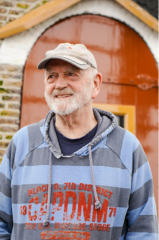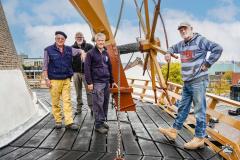The story of Carl Doeke Eisma miller of Wassenaar
Before the restoration, the sails of the characteristic corn mill Windlust turned every Saturday. The name of the mill betrays that it turns on the wind. That sounds simpler than it is; there is a lot of skill involved in grinding grain into flour. Carl Doeke Eisma has been working as a volunteer miller on the Wassenaar stage mill since 1986. He talks enthusiastically about his passion for the beautiful old craft, which has changed very little over the centuries.
'Well no, I had no plans at all to become a miller. It was just pure coincidence," says Carl. "I was in education and on vacation, it must have been 1984, I got talking to a miller. The man could speak so passionately about his profession... it stuck with me. Do we actually have a mill in Wassenaar?", I asked my wife Hennie. She pointed out Windlust, in the middle of the village.

Climbing the wick
'Then one Saturday afternoon I went to see then-miller Jan van der Veek. 'Can you still use a servant?' I asked him. He already had a lot of farmhands, he said, but I could still fit in. 'Climb the wick,' Jan said. Of course I had to prove my suitability immediately. It was blowing very hard, force 7 I think. With that wind? I'm crazy there,' I said. 'Ok,' said Jan. 'You can come back next week. But if you still don't dare, you never have to come back. And he was quite right, of course. You shouldn't be afraid in this business.'
You don't become a miller overnight
'Coincidentally, miller Jan van der Veek was going to move. As owner of Windlust, the municipality of Wassenaar did not want to leave the mill unattended, so a successor had to be found quickly. In 1984 I started the voluntary miller training; a tough two-year course. You have to learn everything about the working of the different kinds of mills, about operation, about safety, about the weather; the latter, by the way, is the part most people fail. Because I wanted to succeed Jan, I managed to do the course in one year. That was a lot of hard work, and in the meantime I was also working in education. In the evenings I was plowing through those huge thick pills about mills...' He laughs: 'At one point my wife also knew all the mill types and the names of the parts.'
Unlucky or lucky
In addition to theory, the training includes two practical exams that take place at another mill. Carl says he had considerable luck with that. 'The first time I got to that mill and one of the sails was in the ground. It was broken and so the party was off. Fortunately, the miller in question had already seen me in action there a few times. He indicated that he could vouch for me. 'That one can do it,' the man said. That was really lucky, Carl thinks. The next exam took place at a mill in Maassluis. Carl: 'I was the fourth and last candidate that day and there was a strange atmosphere. I had to redo several assignments several times. Not because things weren't going well. I know I thought 'Isn't this a bit excessive?' What turned out: my predecessor had had an epileptic fit and had fallen out of one of the blades while submitting a sail. So the examiners were quite upset by that accident. Fortunately, after the insistence of the miller, they decided to let my exam go ahead anyway. And so in 1986, together with Pieter van der Veek (second cousin of miller Jan van der Veek), I was appointed by the municipality of Wassenaar as a volunteer miller. Pieter was not only a miller by the way, he also worked as a millwright at the Verbij company; I really learned the tricks of the trade from him.
Volunteer miller
The Guild of Volunteer Millers was founded in 1972. Carl: "Back then professional millers still existed, hence the need to differentiate. But I always shout 'Why volunteer? I was sent by my wife, so there's nothing voluntary about that.' He laughs. 'Nowadays you can't make a living out of it, so there is no distinction between professional or voluntary. The name will soon change to the Guild of Millers. The nice thing is that people with all kinds of different backgrounds and professions can become millers. Also here in Wassenaar: I come from education, Erik Kopp from the navy and Jeroen Oorsprong is a physicist. Together we always have more than enough to talk about. We hardly ever talk about soccer or women. What millers have in common? Eh.... They must have a bit of a tic I think. What that is exactly I don't know. Later in the conversation, when he relates that some millers used to always live a little outside the law, he jumps up. With twinkling eyes: 'That's it! That does suit me. In my days of Provo's and the Kabouters I was also often outside the established order. That's that tic for me!'

Turning the crank wheel
'How a day at the mill works? You start by hoisting the little flag at the top; the sign that you are there. And then you perform a number of actions in fixed order. First you have to take the mill off the chain. You check where the wind is blowing and with the help of the wheel you turn the sails to the wind and, if necessary, put the sails in front of them. You check the mill and put up the nets for safety, which visitors have to stay behind. Between wind force 4 and 8 you can start grinding; harder is not possible. All in all, if you work well together, this takes about 10 minutes. First you let the mill run free and then you connect the mill to the grinding stone. To grind, you have to set the runner, the upper grinding stone, in motion. It rotates over the beam. The runner weighs about 1500 kilos; so you don't get it moving just like that!
Shaking bucket and folding trowel
'In one of the attics of the mill is a bin: the candle. That is where you deposit 6 to 7 bags of grain for grinding. And then it comes down to the most intelligent part of the mill: the folding spoon. The folding spoon is connected to the shaking bucket. Every time the square rod - which transmits the movement of the sails to the top stone - turns a turn, it taps the tapping spoon and a dash of grain comes between the stones. He gestures with his hand to the rhythm: 'Tick.... Tick.... Tick.... And blows hard then you hear tick-tick-tick-tick-tick.... Who ever thought of that! Really a tremendously clever invention; the whole operation of a grist mill depends on that tapping chip. You put a bag under the flour chute and then the ground whole wheat flour flows into it. As a miller, you pay very close attention to the flour flowing through that flour chute; isn't it going too slow or too fast? Isn't the flour getting too hot? You have to feel and watch carefully. As a miller, you are responsible for the quality of the flour that goes to the baker. So in our case, baker Kaptein. When the 25-kilo flour bag is full, you place a new bag underneath. At wind force 7 you turn such a sack in just 5 minutes!
Corn miller: a profession in its own right
Grinding the corn is a profession in its own right Carl tells, "That is not part of the miller's training. That's why in 1987, together with Pieter van der Veek, I took the supplementary 'Course for Corn Millers'. In that, it was mainly about grinding and setting the grinding stones and billen. He pronounces the word emphatically. 'If I talked about this with school children who visited our mill, they would laugh very loudly. 'Buttocks! But by buttocks we actually mean the buttock. And that is exactly what those buttocks are in the stones: slots that you cut in the millstone. I have done this myself. Touring visitors and school classes is a good thing I think. This way they can really see what is happening and it can be very educational. For school children, the visit is often a combination with kneading and baking a loaf of bread at Kaptein bakery, made from our flour, of course. Their enthusiasm and the open questions are sometimes very disarming.
Language of the mill
I have a thing for language. Among other things, I have been a teacher of Dutch and I have written the necessary books, articles, poems and songs, also for De Wassenaarse Krant. So, linguistically speaking, I also keep myself busy with words like clapping trowel and shaking bucket. By the way, did you know that windmills are also used to communicate with? You can put the sails in joy or in mourning, for example. That wick language certainly used to go a long way, for example in the Zaan region it had become a kind of code language. Even during the war, mills were used as a means of communication. For example, millers agreed with each other how to warn each other. For example, tying an empty grain sack into the sails meant something like "The Germans are coming. The Germans never found out, by the way.
I can fortunately still do the necessary
''Isn't it time to stop,'' my wife asked during this restoration that took much longer than originally thought. Not surprising, by the way. I started in 1986 at age 49, so do the math. Although I could still work with the mill on my own, at my age it is wise not to do so anymore. These days, there are three millers and an apprentice miller, and we work at least in pairs. We know exactly what to do with each other and trust each other completely. This is important, because being a miller is a beautiful profession, but it can also be dangerous. Many mills and millers have died over the centuries. Of course the weather plays a role, such as lightning, which can cause a fire. And you can fall as a miller; there are plenty of hatches and narrow steps and, of course, you climb the sails. You also have to pay close attention to which door you use. If the mill is spiced up, you have to keep the door closed on that side, otherwise you literally get hit by the mill when you go outside.'
What a storyteller this miller is! What a love for Windlust mill on Mill Square, for its history and for its craft.
Author: Yvonne Andrée Wiltens